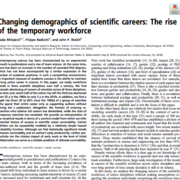
Contemporary science has been characterized by an exponential growth in publications and a rise of team science. At the same time, there has been an increase in the number of awarded PhD degrees, which has not been accompanied by a similar expansion in the number of academic positions. In such a competitive environment, an important measure of academic success is the ability to maintain a long active career in science. In this paper, we study workforce trends in three scientific disciplines over half a century. We find dramatic shortening of careers of scientists across all three disciplines. The time over which half of the cohort has left the field has shortened from 35 y in the 1960s to only 5 y in the 2010s. In addition, we find a rapid rise (from 25 to 60% since the 1960s) of a group of scientists who spend their entire career only as supporting authors without having led a publication. Altogether, the fraction of entering re- searchers who achieve full careers has diminished, while the class of temporary scientists has escalated. We provide an interpretation of our empirical results in terms of a survival model from which we infer potential factors of success in scientific career survivability. Cohort attrition can be successfully modeled by a relatively simple hazard probability function. Although we find statistically significant trends between survivability and an author’s early productivity, neither pro- ductivity nor the citation impact of early work or the level of initial collaboration can serve as a reliable predictor of ultimate survivability. Read more.